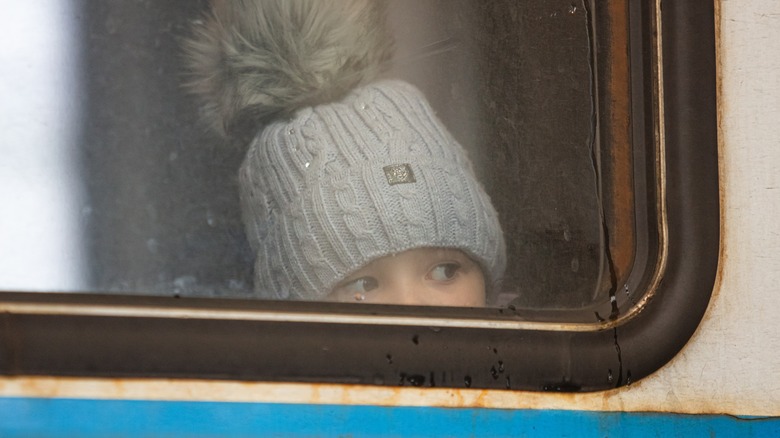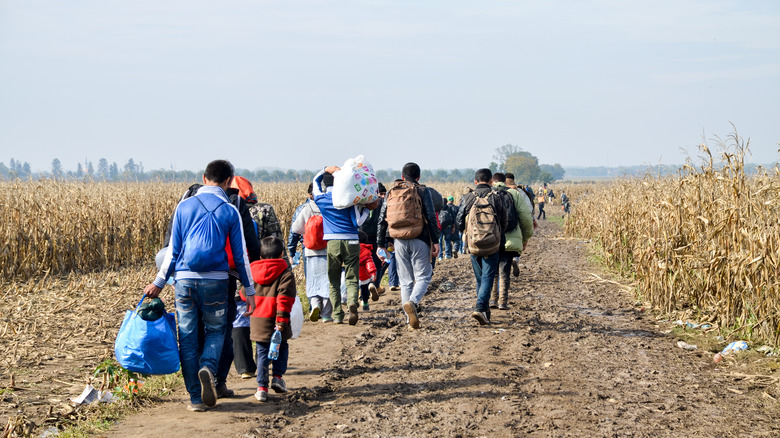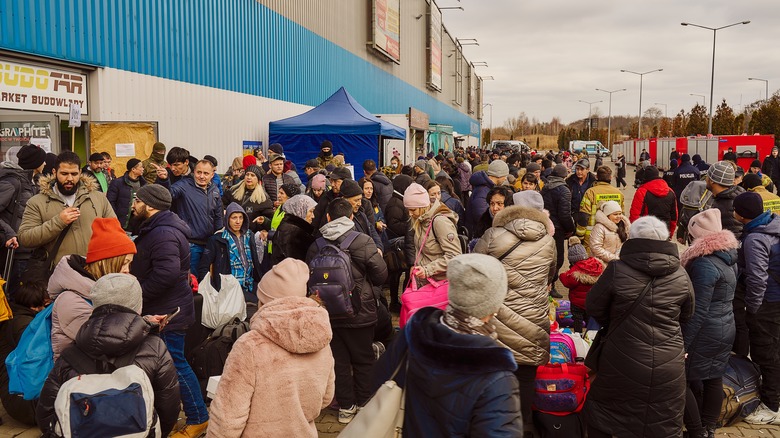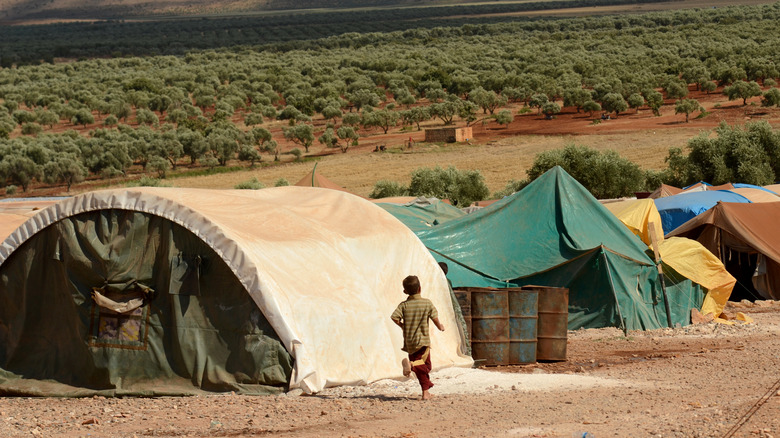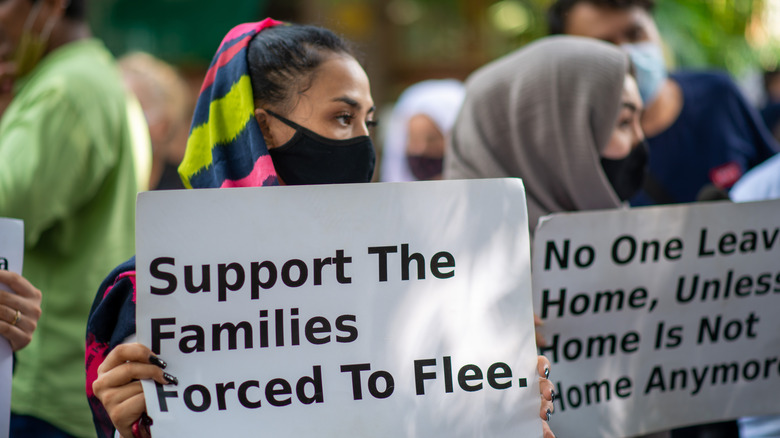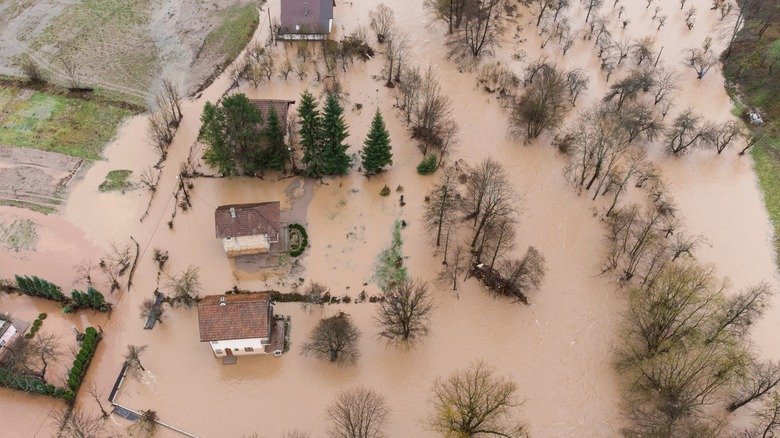The Number Of People Displaced From Their Homes Worldwide Is A Lot More Than You Think
The COVID-19 pandemic, which shut down vast swaths of the planet in 2020 and 2021, made for the most shocking news story of many people's lifetime. The headlines that have dominated TV news and social media in 2022 have made for yet more grim reading. On May 23, the UN Refugee Agency (UNHCR) published a shocking press release, informing the world that the number of displaced people — those forced to leave their homes due to conflicts or humanitarian disasters — has exceeded more than 100 million worldwide, a record number which has horrified analysts and cast light on the human suffering caused by recent world events, especially the ongoing war in Ukraine.
The UN High Commissioner for Refugees, Filippo Grandi, stated via the report: "One hundred million is a stark figure — sobering and alarming in equal measure. It's a record that should never have been set ... This must serve as a wake-up call to resolve and prevent destructive conflicts, end persecution, and address the underlying causes that force innocent people to flee their homes."
But it's not just the events of 2022 that have led to the highest global number of displaced people since records began. Sadly, figures don't look as though they'll be improving anytime soon.
The ongoing refugee crisis
Though 2022 has been dominated by news of the continued conflict in Ukraine, the growing problem of displacement and of refugees traveling the world in search of asylum has been a constant story in recent decades. The more than decade-long conflict in Syria, for example, remains one of the largest-scale humanitarian disasters in recent memory, which has to date forced more than 13.5 million people to leave their homes (via World Vision).
In 2017, the Council for European Studies journal EuropeNow summarized how such recent conflicts around the world had seen the number of displacements balloon to epic proportions, noting that, at the time, some 60 million people around the globe were classed as displaced people. It was believed that half of them were children.
The same source notes that such displacement figures were at their highest level since the horrors of World War II. Nevertheless, the figure increased by roughly two-thirds by the end of 2021, to around 90 million, due to fresh outbreaks of violence in numerous countries. That includes Afghanistan, following the withdrawal of Western troops in 2021, which allowed the Taliban to return to power in the country, as well as nations such Ethiopia, Burkina Faso, Myanmar, Nigeria, and the Democratic Republic of the Congo, per the UNHCR.
Millions more displaced in Ukraine
But 2022 has seen figures jump even higher, as the protracted war in Ukraine has caused a majority of the country's population to flee the violence which has already claimed the lives of thousands of Ukrainian civilians and soldiers, according to Forbes. Per the BBC, some 6 million of Ukraine's population of 41.4 million are estimated to have fled Ukraine, with the majority of refugees escaping to nearby European states such as Poland and Romania, many with injuries or without vital medication or medical equipment abandoned in the panic to escape bombardments in many of Ukraine's major cities.
According to the Ukraine Refugee Situation Operational Data Portal, the vast majority of those fleeing Ukraine entered Poland, which sheltered an estimated 3.5 million Ukrainians in the first three months of the war. As reported by NPR, at the height of the exodus it is believed that around 1,500 refugees were crossing the border into Poland every hour, while medical staff stationed at the borders are estimated to have provided treatment to around 26,000 since the war began.
Growing internal displacement
Though the image of refugees naturally arises in discussions around displacement, the fact is that many displaced people continue to live in their own lands, but are forced to live a peripatetic existence fleeing from conflict, hunger, and oppression. The Internal Displacement Monitoring Center's annual figures indicate that the number of people worldwide who were victims of internal displacement as a result of conflict, oppression, or natural disasters stood at around 59.1 million at the end of 2021. However, this figure has jumped significantly following the outbreak of war in Ukraine, as almost 8 million people — or almost 20% of the country's population — are estimated to have been internally displaced as of May 2022.
Disturbingly, the United Nations Office of the High Commissioner for Human Rights estimates that, while millions have been forced to flee their homes to avoid the ongoing violence, around 13 million Ukrainians have found themselves "stranded" in conflict zones throughout the country, unable to flee due to a lack of resources, or mobility issues arising from disability or old age.
The international response
Per the UNHCR, passing the record number of 100 million displaced people worldwide means that 1% of the world's population has been forced from their homes for their own safety, a damning indictment of international progress in the 21st century. High Commissioner for Refugees Filippo Grandi has, however, praised the support shown by western nations in the face of such a troubling humanitarian crisis, stating, "The international response to people fleeing war in Ukraine has been overwhelmingly positive ... Compassion is alive." Grandi also suggested that those offering support to Ukraine should widen their activities in the face of ongoing mass displacement, arguing for "similar mobilization [to that seen in Ukraine] for all crises around the world. But ultimately, humanitarian aid is a palliative, not a cure. To reverse this trend, the only answer is peace and stability so that innocent people are not forced to gamble between acute danger at home or precarious flight and exile."
However, as noted by UN News, further displacement has occurred in recent months, notably in the Asia-Pacific region. There, more than 23 million people are believed to have been displaced as a result of floods and other forms of extreme weather.
Future threats of displacement
As noted by the Migration Data Portal, those who have experienced displacement are often described in the media as having done so as a result of either human-driven conflict, or by natural disasters beyond human control. However, in the 21st century experts have begun to argue that these categories are beginning to overlap to more and more often, and will continue to do so as the climate crisis takes hold.
The same source notes that "human activity," such as mining, can directly lead to disasters such as landslides which cause local populations to flee their homes. Similarly, conflicts may often arise as neighboring groups vie for control of limited natural resources and the lands where they are found.
Another cause for concern is that while nations attempt to shelter around 100 million displaced people, figures are increasingly coming to include what National Geographic calls "environmental refugees" — those who are displaced as a direct consequence of climate change, man-made or otherwise. According to the same source, some experts warn that as soon as 2050 some 200 million people may be displaced as environmental refugees, owing to global warming and rising sea levels. The UNHCR warned in a November 2021 video (posted on YouTube): "The climate crisis is a human crisis ... destroying livelihoods, driving displacement and feeding conflict, putting millions of lives at risk ... We must act now."
